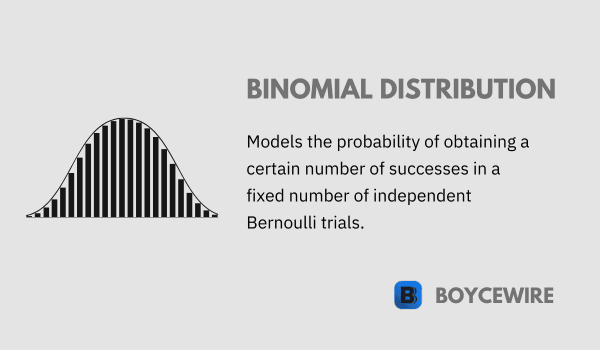Binomial Distribution: Definition, Formula & Examples

What is Binomial Distribution?
In the realm of probability and statistics, the binomial distribution stands as one of the most fundamental and widely used concepts. Its simplicity, yet profound applicability, make it an essential component in a myriad of fields – from conducting medical trials, predicting voting outcomes, quality control in manufacturing, to understanding behavioral patterns in social sciences, and beyond.
The binomial distribution is a discrete probability distribution that describes the number of successes in a fixed number of independent Bernoulli trials with the same success probability. Essentially, it provides a mathematical framework to predict the probability of a specific outcome in a series of events or trials, where each event has precisely two possible outcomes – success or failure.
Key Points
- The binomial distribution describes the probability of obtaining a certain number of successes (k) in a fixed number of independent Bernoulli trials (n).
- Each trial in the binomial distribution has only two possible outcomes: success or failure.
- The binomial distribution is characterized by two parameters: the number of trials (n) and the probability of success in each trial (p).
Understanding Binomial Distribution
The binomial distribution is one of the cornerstone concepts in statistics and probability theory. Before diving into its properties and calculation, let’s first break down the basic terminologies and concepts.
1. Concept of a Bernoulli Trial
A Bernoulli trial (or Bernoulli experiment) is a random experiment with exactly two possible outcomes: “success” and “failure”, where “success” is defined as the outcome of interest. The probability of “success” is denoted by p, and “failure” is denoted by q (or 1-p, since the total probability must sum to 1). A simple example is flipping a coin, where getting a head might be termed a “success” and a tail a “failure”.
2. Components of a Binomial Experiment
A binomial experiment involves conducting a fixed number of Bernoulli trials, where each trial is independent of the others and has the same probability of success. The four main characteristics of a binomial experiment are:
- The experiment consists of n repeated trials.
- Each trial can result in just two possible outcomes (success or failure).
- The probability of success, denoted by p, is the same on every trial.
- The trials are independent; the outcome on one trial does not affect the outcome on other trials.
3. Understanding Binomial Coefficients
A binomial coefficient, typically represented as ‘n choose k’ or C(n, k), is the number of ways to choose k successes from n trials and is an integral part of the formula for a binomial distribution. It can be calculated using the formula:
C(n, k) = n! / [k!(n-k)!]
where “!” denotes factorial, which is the product of all positive integers up to that number. For example, 5! = 5 * 4 * 3 * 2 * 1 = 120.
The foundation of understanding binomial distribution lies in grasping these basic concepts and principles. Once these fundamentals are clear, we can dive deeper into understanding the properties, calculations, and applications of the binomial distribution.
Properties of Binomial Distribution
The binomial distribution, like any probability distribution, is characterized by certain properties that describe its shape, central tendency, and spread. Here we delve into these features, including its mean, variance, symmetry, and relationship with other distributions.
1. Mean, Variance, and Standard Deviation
The mean (μ) of a binomial distribution, which gives its central tendency, is the product of the number of trials (n) and the probability of success (p) on each trial. Mathematically, it is represented as:
μ = n * p
The variance (σ^2), which signifies the spread or dispersion in the distribution, is the product of the number of trials, the probability of success, and the probability of failure (q, where q = 1 – p). It can be written as:
σ^2 = n * p * q
The standard deviation (σ) is simply the square root of the variance.
2. Symmetry and Skewness
The shape of a binomial distribution depends on the values of n and p. If p is close to 0.5, the distribution tends to be symmetric, especially for larger n. If p is notably different from 0.5, the distribution becomes skewed. For p < 0.5, it is positively skewed (i.e., skewed right), and for p > 0.5, it is negatively skewed (i.e., skewed left).
3. Relationship with Other Distributions
Normal Distribution: If the number of trials (n) is large, the binomial distribution tends to approximate a normal distribution, according to the Central Limit Theorem. The closer the probability of success (p) is to 0.5, the better this approximation.
Poisson Distribution: If the number of trials (n) is large, and the probability of success (p) is small, the binomial distribution can be approximated by a Poisson distribution with λ = n*p.
These properties of the binomial distribution are fundamental to its understanding and application. They influence how we calculate binomial probabilities and conduct statistical tests using this distribution.
Calculating Binomial Probability
The probability of observing a particular number of “successes” in a binomial experiment is calculated using the binomial probability formula.
1. Definition of Binomial Probability
Binomial probability refers to the probability of obtaining exactly x successes in n independent Bernoulli trials.
2. Formula and Calculation of Binomial Probability
The binomial probability formula is expressed as:
P(X = x) = C(n, x) * (p^x) * (q^(n-x))
where:
- P(X = x) is the binomial probability,
- C(n, x) is the number of combinations of n items taken x at a time,
- p is the probability of success on a single trial,
- q is the probability of failure on a single trial (q = 1 – p),
- x is the number of successes,
- n is the number of trials.
The term C(n, x) represents the number of ways to choose x successes from n trials. The term (p^x) represents the probability of getting x successes, and the term (q^(n-x)) represents the probability of getting n – x failures.
3. Example
Suppose we are flipping a fair coin (p = 0.5) 10 times (n = 10), and we want to find the probability of getting exactly 5 heads (x = 5). Using the formula:
C(10, 5) = 10! / [5!(10-5)!] = 252
So,
P(X = 5) = C(10, 5) * (0.5^5) * (0.5^(10-5))
= 252 * 0.03125 * 0.03125
= 0.246
Hence, there is approximately a 24.6% chance of getting exactly 5 heads when flipping a fair coin 10 times.
Understanding how to calculate binomial probability allows us to answer a wide range of questions about the likelihood of various outcomes, given a specific number of trials and probability of success.
Assumptions and Limitations of Binomial Distribution
While binomial distribution is a powerful tool in probability theory and statistics, it rests on certain assumptions and comes with inherent limitations. Understanding these is crucial for its correct application and interpretation.
Key Assumptions
- Number of Trials: The number of trials (n) should be fixed in advance. The experiment stops after a predetermined number of trials have been conducted.
- Independence: Each trial must be independent, meaning the outcome of one trial does not influence the outcome of another trial.
- Outcome: Each trial should result in one of two possible outcomes – success or failure.
- Probability of Success: The probability of success (p) should be the same for each trial.
Potential Limitations and Misuse
- Misjudging Independence: A common mistake is to assume that trials are independent when they are not. For example, if one is sampling without replacement, the trials are not independent, and the binomial distribution may not be the appropriate model.
- Varying Probability: The assumption of a constant probability of success can be violated in real-world scenarios where the probability changes over time or between trials.
- Only Two Outcomes: Binomial distribution may not fit well with experiments where outcomes are more than two or are not easily dichotomized.
- Large Sample Size: For large samples, calculations involving binomial distribution can become unwieldy or computationally intensive. In such cases, normal or Poisson distributions might be used as approximations, but they might not perfectly match the true distribution.
- Small Sample Size: On the flip side, with a small sample size, the distribution may be highly skewed, leading to potentially inaccurate estimations or predictions.
Understanding these assumptions and potential limitations allows us to determine when it’s appropriate to use the binomial distribution and helps prevent misuse or misinterpretation of statistical results.
FAQs
The binomial distribution is a discrete probability distribution that describes the number of successes in a fixed number of independent Bernoulli trials, where each trial has only two possible outcomes (success or failure).
The key characteristics of the binomial distribution include a fixed number of trials (n), a constant probability of success (p), independent trials, and a discrete outcome of either success or failure.
Bernoulli trials are independent experiments or events that have only two possible outcomes, typically referred to as success (typically denoted as 1) and failure (typically denoted as 0).
The probability mass function calculates the probability of observing a specific number of successes (k) in a fixed number of trials (n) with a constant probability of success (p).
About Paul
Paul Boyce is an economics editor with over 10 years experience in the industry. Currently working as a consultant within the financial services sector, Paul is the CEO and chief editor of BoyceWire. He has written publications for FEE, the Mises Institute, and many others.

Further Reading
 Mixed Economy: Definition, Pros, Cons & Examples - A mixed economy is an economic system that combines elements of a capitalist, market-based system, with a socialist, command economy…
Mixed Economy: Definition, Pros, Cons & Examples - A mixed economy is an economic system that combines elements of a capitalist, market-based system, with a socialist, command economy…  Prospect Theory: Definition & Examples - Prospect theory is based upon the premise that individuals value losses and gains differently.
Prospect Theory: Definition & Examples - Prospect theory is based upon the premise that individuals value losses and gains differently.  Enron Scandal - The Enron scandal refers to a major corporate fraud involving the energy company Enron Corporation, characterized by deceptive accounting practices…
Enron Scandal - The Enron scandal refers to a major corporate fraud involving the energy company Enron Corporation, characterized by deceptive accounting practices… 
